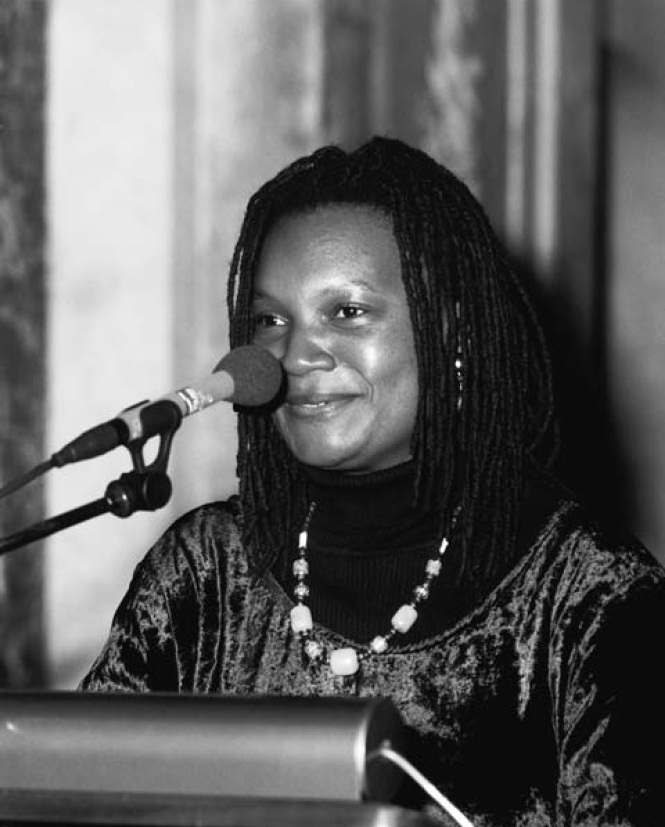My first time to read Yvonne Vera, about 14 years ago, I wished I had written most of her novels and short stories. One particular story that stood out was, Why Don’t You Carve other Animals. Lately I’ve been thinking about that story, rereading, and still wishing that I had written it.
I first saw Yvonne Vera at the Zimbawe International Bookfair in 2000. Like any upcoming writer, I was hungry for contact with established writers. So I approached her, made conversation, and received her blessings. She autographed my books, and for many nights all I had to do was look at her signature, with love and affection, look at her picture, and believe that I could walk the writers’ path.
I loved the intensity and economy of her words, the depth of her stories, and their profound meanings. I loved their cleverness, and how understated the way she tackled post-colonial, ideological positions. The most poignant paragraph for me In Why Don’t You Carve Other Animals is this:
‘The elephant has ruled the forest for a long time, he is older than the forest, but the giraffe extends his neck and struts above the trees, as though the forest belonged to him. He eats the topmost leaves, while the elephant spends the day rolling in the mud. Do you not find it interesting? This struggle between the elephant and the giraffe, to eat the topmost leaves in the forest?’
I couldn’t help but think about White rule in Rhodesia, and the Black people’s struggle to regain control of their land. Her skilled use of metaphors, creative titles, strong female characters and voices are some of the elements that stand out in her works.
At 40, Yvonne Vera died in 2005. She was working on a new novel, Obedience. She left with us one collection of short stories, and five most profound novels:
- Nehanda (1993), short-listed for Commonwealth Writers’ Prize
- Without a Name (1994), awarded Commonwealth Writers’ Prize for Africa and Zimbabwe Publishers’ Literary Award
- Under the Tongue (1997)
- Butterfly Burning (2000), awarded German Literature Prize 2002,chosen as one of Africa’s 100 Best Books of the 20th Century in 2002
- The Stone Virgins (2002), awarded Macmillan Writers’ Prize for Africa
To get a taste of her writings, here’s the complete short story: Why Don’t You Carve other Animals, TSAR Publications (1992, 2003)
He sits outside the gates of the Africans-Only hospital, making models out of wood. The finished products are on old newspapers on the ground around him. A painter sits to his right, his finished work leaning against the hospital fence behind them. In the dense township, cars screech, crowds flow by, voices rise, and ambulances speed into the emergency unit of the hospital, their flashing orange light giving fair warning to oncoming traffic. Through the elephants he carves, and also the giraffes, with oddly slanting necks, the sculptor brings the jungle to the city. His animals walk on the printed newspaper sheets, but he mourns that they have no life in them. Sometimes in a fit of anger he collects his animals and throws them frenziedly into his cardboard box, desiring not to see their lifeless forms against the chaotic movement of traffic which flows through the hospital gates.
‘Do you want that crocodile? It’s a good crocodile. Do you want it?’ A mother coaxes a little boy who has been crying after his hospital visit. A white bandage is wrapped tight around his right arm. The boy holds his arm with his other hand, aware of the mother’s attention, which makes him draw attention to his temporary deformity. She kneels beside him and looks into his eyes, pleading.
‘He had an injection. You know how the children fear the needle,’ the mother informs the man. She buys the crocodile, and hands it to the boy. The man watches one of his animals go, carried between the little boy’s tiny fingers. His animals have no life in them, and the man is tempted to put them back in the box. He wonders if the child will ever see a moving crocodile, surrounded as he is by the barren city, where the only rivers are tarred roads.
A man in a white coat stands looking at the elephants, and at the man who continues carving. He picks a red elephant, whose tusk is carved along its body, so that it cannot raise it. A red elephant? The stranger is perplexed, and amused, and decides to buy the elephant, though it is poorly carved and cannot lift its tusk. He will place it beside the window in his office, where it can look out at the patients in the queue. Why are there no eyes carved on the elephant? Perhaps the paint has covered them up.
The carver suddenly curses.
‘What is wrong?’ the painter asks.
‘Look at the neck of this giraffe.’
The painter looks at the giraffe, and the two men explode into uneasy laughter. It is not easy to laugh when one sits so close to the sick. The carver wonders if he has not carved some image of himself, or of some afflicted person who stopped and looked at his breathless animals. He looks at the cardboard box beside him, and decides to place it in the shade, away from view.
‘Why don’t you carve other animals. Like lions and chimpanzees?’ the painter asks. ‘You are always carving giraffes and your only crocodile has been bought!’ The painter has had some influence on the work of the carver, lending him the paints to colour his animals. The red elephant was his idea.
‘The elephant has ruled the forest for a long time, he is older than the forest, but the giraffe extends his neck and struts above the trees, as though the forest belonged to him. He eats the topmost leaves, while the elephant spends the day rolling in the mud. Do you not find it interesting? This struggle between the elephant and the giraffe, to eat the topmost leaves in the forest?’ The ambulances whiz past, into the emergency unit of the Africans-Only hospital.
The painter thinks briefly, while he puts the final touches on an image of the Victoria Falls which he paints from a memory gathered from newspapers and magazines. He has never seen the Falls. The water must be blue, to give emotion to the picture, he thinks. He has been told that when the water is shown on a map, it has to be blue, and that indeed when there is a lot of it, as in the sea, the water looks like the sky. So he is generous in his depiction, and shocking blue waves cascade unnaturally over the rocky precipice.
‘The giraffe walks proudly, majestically, because of the beautiful tapestry that he carries on his back. That is what the struggle is about. Otherwise they are equals, the elephant has his long tusk to reach the leaves and the giraffe has his long neck.’
He inserts two lovers at the corner of the picture, their arms around each other as they stare their love into the blue water. He wants to make the water sing to them. So he paints a bird at the top of the painting, hovering over the falls, its beak open in song. He wishes he had painted a dove, instead of this black bird which looks like a crow.
The carver borrows some paint and puts yellow and black spots on the giraffe with the short neck. He has long accepted that he cannot carve perfect animals, but will not throw them away. Maybe someone, walking out of the Africans-Only hospital, will seek some cheer in his piece. But when he has finished applying the dots, the paint runs down the sides of the animal, and it looks a little like a zebra.
‘Why do you never carve a dog or a cat? Something that city people have seen. Even a rat would be good, there are lots of rats in the township!’ There is much laughter. The painter realizes that a lot of spray from the falls must be reaching the lovers, so he paints off their heads with a red umbrella. He notices suddenly that something is missing in the picture, so he extends the lovers’ free hands, and gives them some yellow ice cream. The picture is now full of life.
‘What is the point of carving a dog? Why do you not paint dogs and cats and mice?’ The carver has never seen the elephant or the giraffe that he carves so ardently. He picks up a piece of unformed wood.
Will it be a giraffe or an elephant? His carving is also his dreaming.


6 Responses to Why Don’t You Carve Other Animals: Yvonne Vera